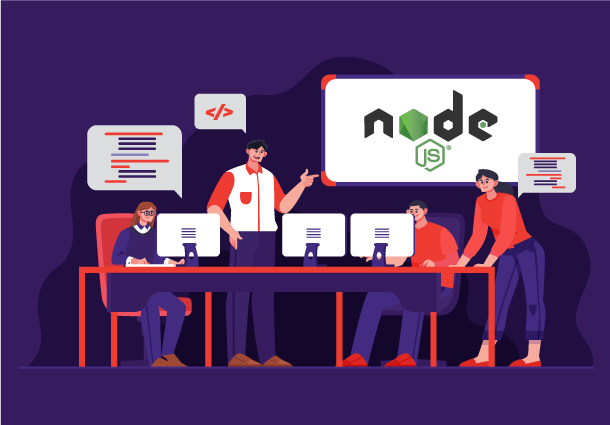An Introductory Discourse on Empowering Scalable Backend Solutions
Node.js has transformed the horizon of backend development, providing a strong environment that uses JavaScript for creating affordable and effective apps on demand. Being an open-source cross-platform runtime environment, Node.js helps the developer execute Javascript code outside of web browsers, thereby opening many possibilities for server scripting. In this guide, we dive into some key tactics that will help developers optimize the potential of Node.js backend development for both novice and veteran professionals alike.  To begin with, understanding Node.js is very important as a backdrop for this explanation. One of its most distinctive features is its asynchronous event-driven architecture, through which developers can create applications that will perform optimally under heavy concurrent loads.
To begin with, understanding Node.js is very important as a backdrop for this explanation. One of its most distinctive features is its asynchronous event-driven architecture, through which developers can create applications that will perform optimally under heavy concurrent loads.
Prior to proceeding with the details of Node.js, it is crucial that a properly configured development environment be established first. Hence, with Node.js installed on your workstation and NPM at hand, you will be able to handle the dependencies without any issues. We navigated through the core components, highlighting the relevance of asynchronous programming, suitable framework choices, and modular code structures. We go into the details of database integration, middleware, and security features before finally discussing performance optimization and testing stages, all necessary in making effective Node.js applications. By implementing these hacks, one can unleash the full advantage of Node js for backend development.
A Confluence of Node JS backend as Revolutionizing Landscape
Why to use Node.js For Backend Development? The fundamental feature of Node.js and its event-driven architecture, which produces non-blocking, asynchronous models, is the ability for clients and servers to share code, which lowers the learning curve for developers and promotes more effective, unified software development.
As a result, the server can process requests one at a time without having to wait for one to finish before responding to another. Because of this, Node.js is incredibly well suited for developing real-time applications where responsiveness is crucial, like chat apps and online gaming systems. Node.js’s efficiency stems from its architecture, which enables applications to manage numerous concurrent transactions. Because of this, Node.js is an excellent tool for developing high-performance, data-intensive applications that need to respond quickly, like social media platforms and streaming services.
Because of its exceptional scalability, backend development using Node js is a great option for applications with varying workloads and its lightweight, event-driven architecture, applications can be scaled incrementally and easily managed to handle high traffic volumes. This scalability is very helpful, particularly for startups, as it allows for functionality to be modified to accommodate changing user requirements without sacrificing functionality.
The thriving and dynamic Node.js community is essential to the language’s success. It’s much simpler to troubleshoot, share best practices, and keep up with the newest trends when there are a plethora of seasoned entrepreneurs, forums, and resources available. The collaborative environment promoted by this community-driven support allows entrepreneurs to overcome obstacles and further develop their skills in Node js backend.
A Comparative Analysis of Node.js and Web JavaScript
Although web JavaScript and Node.js both use the JavaScript programming language, they have different uses and operate in different contexts. Developers who wish to create scalable and reliable applications for client-side and server-side development must be aware of this distinction. The execution environments of web JavaScript and Node.js differ primarily from one another.
Web page elements can be managed and altered by Web JavaScript, which operates in the browser and communicates with the Document Object Model (DOM). On the other hand, Node.js is a server-side framework that runs JavaScript behind the browser to simplify server-side development with either Node js backend or frontend. This file-I/o, network, festival, observation, etc., is renowned for its architecture in this morally questionable and unparalleled incident, wherein the web is a transient manifestation of the contemporary network. After tracking the copy, it employs an event-driven strategy with promises or callbacks from Node.js.
is renowned for its architecture in this morally questionable and unparalleled incident, wherein the web is a transient manifestation of the contemporary network. After tracking the copy, it employs an event-driven strategy with promises or callbacks from Node.js.
Modular programming is supported by both web JavaScript and Node.js, but Node.js goes one step further due to its built-in support for modules. The Common JS module framework, which is used by Node.js, enables developers to tidily manage dependencies and divide code into reusable modules. Node Package Manager (NPM) enhances the dynamic ecosystem of open-source modules by making the process of installing and managing third-party libraries and systems even simpler.
Backend development with Node js gives developers access to system resources, allowing them to interact with the underlying control system and carry out system commands. For server-side applications that might need to do things like read and write files, run shell commands, or access environment variables, this functionality is crucial. Restricted by browser security limitations This level of system resources for accessibility is absent from Web JavaScript. On the other hand, Node js backend framework is more appropriate for developing server-side programs, like web servers, APIs, and microservices.
Node.js as the Key Enabler for Seamless Enterprise Software Ecosystems
Netflix is among the top developers utilizing Node.js’s capabilities. The world’s largest streaming provider depends on Node.js to provide millions of users with a smooth and continuous streaming experience. Node.js guarantees that users won’t experience buffering or latency when watching their preferred content. LinkedIn is another noteworthy example. Node.js is used by the enterprise communication system to build scalable and quick server-side applications. Because so many people use LinkedIn on a daily basis, the platform can handle massive amounts of connections with ease due to Node js backend framework. This guarantees that users will always have a smooth experience, whether they are interacting with employees, requesting services, or using products.
Walmart, a massive retailer, is another business that gains from Node.js. Walmart enhances the functionality of its eCommerce platform with a backend for Node js. The productive handling of concurrent transactions by Node.js is particularly helpful in situations where web traffic volume is high. This guarantees that users won’t experience lag or errors when searching, buying, and completing services.
Beyond the domains of entertainment and e-commerce, Node.js has demonstrated its worth in numerous other areas. The most popular online payment system, PayPal, depends on Node.js for its functionality and speed. PayPal can manage numerous transactions in real-time with Node.js, guaranteeing that users receive payments quickly and securely. Backend development with node js will probably continue to be essential in enabling big businesses to provide their users with cutting-edge, high-performing web applications as the digital landscape develops.
The Role of Node.js in Netflix’s Agile Software Development Paradigm
Netflix uses Node.js as a vital part of its tech stack to improve the functionality and scalability of its streaming service delivery platform. Due to its features of being fast and light-weighted, Node.js proves itself perfect for the streaming service provided by Netflix, as such applications are basically large-scale and real-time-based ones. The main use of Node js backend or frontend by Netflix is in the creation of its user interface. The platform’s client-side apps that provide flawless, fluid performance for the users are developed in Node.js.  This allows Netflix to consolidate its codebase using JavaScript on both the server and client sides. This lean development process leads to more rapid iterations and many feature rollouts.
This allows Netflix to consolidate its codebase using JavaScript on both the server and client sides. This lean development process leads to more rapid iterations and many feature rollouts.
Moreover, the Node js backend is a very important component of Netflix’s backend infrastructure that contributes to the development of a really reliable and scalable server structure. Considering that Node.js employs an event-driven, non-blocking model to efficiently manage a large number of concurrent connections, Netflix guarantees seamless streaming quality for many millions of users worldwide.
This is extremely advantageous, particularly for a platform like Netflix, where low-latency communication is very important to ensure nonstop content delivery. In addition, Netflix utilizes backend development using Node js in building microservices to support essential platform features such as user recommendations and content delivery. Such a microservices architecture provides better scalability and maintainability, which means that the different services can be independently developed as well as deployed.
Pattem Digital’s Inimitable Impact of Node.js on Backend Ingenuity
Node.js’s single language approach, event-driven architecture, high performance, vast package ecosystem, scalability, and strong community support make it an impressive competitor in backend development. To use JavaScript, developers use Node.js; its features span the whole software stack. You can bring in a new era of effective and comprehensive web development by doing so. We are Pattern Digital- an exceptional Node.js development company, delivering unparalleled backend services that redefine digital excellence. With a proven track record of innovation, our Node.js solutions seamlessly blend cutting-edge technology with reliability.
Our dedicated team of experts harnesses the power of Node.js to craft powerful and scalable backend systems, ensuring optimal performance for your applications. We go beyond conventional development, offering transformative Node.js solutions that elevate your digital presence. Our commitment to excellence is reflected in our ability to create bespoke, high-performance backend services tailored to your unique needs. Trust us to propel your projects forward with the speed, efficiency, and versatility that Node.js brings to the table. Experience the next level of digital development with us — where expertise meets unbelievable commitment to your success.





